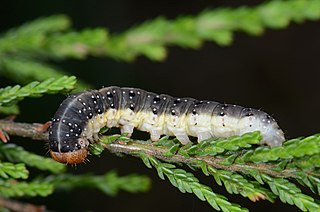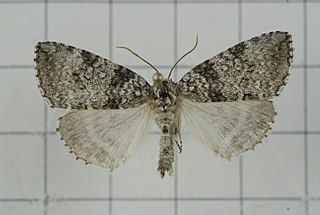
Achlya flavicornis, the yellow horned, is a moth of the family Drepanidae. The species was first described by Carl Linnaeus in his 1758 10th edition of Systema Naturae. It is found from Europe to the eastern Palearctic ecozone.

Tetheella is a monotypic moth genus in the family Drepanidae described by Werny in 1966. Its single species, Tetheella fluctuosa, the satin lutestring, was described by Jacob Hübner in 1803. It is found from western Europe across the Palearctic to Kamchatka, Sakhalin Island, Korea and Japan.

Nordstromia grisearia is a moth in the family Drepanidae. It was described by Otto Staudinger in 1892. It is found in the Russian Far East, Japan and China.

Achlya is a genus of moths belonging to the subfamily Thyatirinae of the Drepanidae.

Polyploca is a genus of moths belonging to the subfamily Thyatirinae of the Drepanidae.

Oreta turpis is a moth in the family Drepanidae. It was described by Arthur Gardiner Butler in 1877. It is found in Japan, the Russian Far East, Korea and China (Shandong).
Oreta paki is a moth in the family Drepanidae. It was described by Hiroshi Inoue in 1964. It is found in Korea, China and the Russian Far East.
Ditrigona komarovi is a moth in the family Drepanidae. It was described by Alekseya Ivanovitch Kurentzov in 1935. It is found in Ussuri in the Russian Far East.
Achlya longipennis is a moth in the family Drepanidae. It was described by Hiroshi Inoue in 1972. It is found in Japan and the Russian Far East. The habitat consists of various types of mixed and broad-leaved forests.
Epipsestis ornata is a moth in the family Drepanidae. It was described by John Henry Leech in 1889. It is found in Japan, the Korean Peninsula, the Russian Far East and the Chinese provinces of Heilongjiang, Jilin and Shaanxi.
Epipsestis nigropunctata is a moth in the family Drepanidae. It is found in China, Japan, Korea, the Russian Far East and Nepal.

Habrosyne dieckmanni is a moth in the family Drepanidae. It is found in the Russian Far East, Japan, north-eastern China and Korea.
Habrosyne intermedia is a moth in the family Drepanidae. It is found in the Russian Far East, the Korean Peninsula, Japan, India, Nepal and China.
Habrosyne violacea is a moth in the family Drepanidae. It is found in the Russian Far East, Korea, China, Myanmar, Vietnam, Nepal and Sikkim, India.
Nothoploca nigripunctata is a moth in the family Drepanidae. It is found in India, Vietnam, Korea, China and the Russian Far East.
Neoploca is a genus of moths belonging to the subfamily Thyatirinae of the Drepanidae. It was first described by Shōnen Matsumura in 1927. It contains only one species, Neoploca arctipennis, first described by Arthur Gardiner Butler in 1878, which is found in Japan, Korea, the Russian Far East and China.

Tethea octogesima is a moth in the family Drepanidae first described by Arthur Gardiner Butler in 1878. It is found in Japan, Korea, China, Taiwan and the Russian Far East.
Tethea trifolium is a moth in the family Drepanidae. It is found in China, the Russian Far East and Japan. The habitat consists of various types of mixed and broad-leaved forests.
Nemacerota tancrei is a moth in the family Drepanidae. It was described by Ludwig Carl Friedrich Graeser in 1888. It is found in the Russian Far East, the Korean Peninsula, Japan and China.

Parapsestis argenteopicta is a moth in the family Drepanidae. It was described by Oberthür in 1879. It is found in the Russian Far East, Korea, Japan, Taiwan, western, north-eastern, northern and central China and Nepal. The habitat consists of various types of mixed forests and oak woods.








